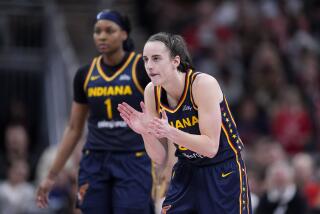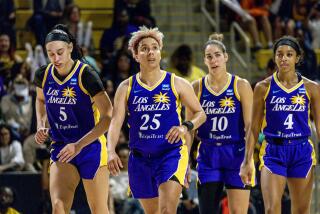Taking a shine to success
- Share via
PHOENIX — The Suns rise annually these days with so little mystery, assistant coach Alvin Gentry, greeting San Antonio assistant P.J. Carlesimo before a recent meeting, doesn’t mind giving up their game plan.
“We’re going to run high pick-and-roll,” says Gentry, laughing, “wing pick-and-roll.”
Not that this is a surprise to the Spurs, who may be No. 1 in defense but couldn’t stop the Suns if Steve Nash told them what they were going to run.
One hundred and three points later (eight under their average in a subpar performance after scoring only 16 in the first quarter), the Suns win by 16.
The Suns have been doing this so long (only Dallas and San Antonio have more wins over three seasons) -- amid so much skepticism about doing it in the playoffs (while they and the Miami Heat were the only teams to make the last two final fours) -- it’s easy to forget all that they overcame and how good they had to be to do it.
In 2004-05, the Suns won 62 games, coming off a 29-53 season in which management traded Stephon Marbury and melted the team down to start over.
In 2005-06, they won 54 after losing three starters, ignoring an internal tremor as new owner Robert Sarver showed general manager Bryan Colangelo the door.
This season’s team, considered their best, had its own issues, starting with Amare Stoudemire’s brief comeback last spring while teammates seemed to roll their eyes.
This was followed by Stoudemire’s brief training camp while teammates seemed to roll their eyes.
Then came their 1-5 start with Stoudemire opening the season on the bench and seeming to roll his eyes.
“We didn’t have a great training camp, but I knew that would change once we got a couple weeks under our belt,” Coach Mike D’Antoni says. “What I didn’t know was Amare. At the time he wasn’t 100%....
“I was worried to death. I was worried, what if he doesn’t get back into form until January, February, are we going to be under .500?”
They’ve gone 44-9 since and if you throw out the games Nash missed, it’s been 42-5. All eyes are on the prize with everyone else gulping at the thought of meeting the Suns in those playoffs they aren’t supposed to be any good in.
“Good basketball teams are good basketball teams,” said San Antonio Coach Gregg Popovich, whose Spurs eliminated the Suns in the 2005 Western Conference finals. “First of all, I think they’re playing better defense now than they’ve ever played before. Offensively, I think they’re more dangerous than they’ve ever been and tougher to guard than they’ve ever been. And I think their confidence level’s higher than it’s ever been.”
The Suns may not be defying tradition as much as pioneering a new one, as hidebound defensive stalwarts such as the Heat, the Detroit Pistons and the Houston Rockets open up their offenses.
Two seasons ago, when Nash returned to the team, the Suns were No. 1 in offense at 110.4 points a game with five more teams over 100.
Now they’re No. 1 at 110.7 with nine more over 100 and a league average of 98.7, the highest in 12 seasons.
Of course, nobody ever said it was easy to be a pioneer, as the Suns also learn annually.
Gentlemen, start your engines
“Nash is the system. I don’t mean to shortchange anybody else, but he’s the best basketball player on the face of the earth. ... I don’t think it’s even close.”
-- Chicago Bulls Coach Scott Skiles
There is no mystery as to how this started. It was July 14, 2004, when Nash, a 31-year-old former Sun who’d spent six seasons in Dallas, re-signed with Phoenix.
Nash was a two-time All-Star but the Mavericks, facing bigger, better teams such as the Lakers, Spurs and Sacramento Kings, made the conference finals only once.
With owner Mark Cuban already regretting Michael Finley’s new deal and Dirk Nowitzki coming up next, Nash asked Cuban to match or approach the Suns’ six-year, $63-million offer.
Cuban offered $39 million over four years, later writing in his blog, “It was Steve’s choice to leave for money. It was my choice not to pay him the money.”
The post is no longer on the site, but one that Cuban wrote that summer is still there. It began:
“ ‘How could you let Steve Nash go?’ It’s a question I’m going to hear for a long time.”
Cuban didn’t know the half of it. Nash has since won two consecutive MVPs and is now posting even better numbers (19 points, 53% shooting, 48% on three-pointers) than he did in those seasons.
In Phoenix, Nash found two super-athletes who could play a position (or two) bigger than their size: 6-foot-7 Shawn Marion, a 20-point scorer and a top-10 rebounder, and 6-8 1/2 Stoudemire, who dunked over centers and anyone else.
Now Nash and Stoudemire run their pick-and-rolls with teammates arrayed on the three-point line, spreading opposing defenses too thin to bring help.
With Nash’s deadeye shooting and playmaking, Stoudemire’s ability to finish, Marion slicing through gaps and the team shooting a league-best 40% on threes, it’s more than anyone can handle. Miami Coach Pat Riley, thankful he sees the Suns only twice a season, announced, “I don’t have a game for them.”
“Steve just has a very high intelligence level and an even higher innate understanding of the game of basketball,” Popovich says of Nash. “Just a natural understanding of what’s going on the court like very few I’ve ever seen.
“He’s in that category with Larry Bird and Magic Johnson, guys like that who have intuitive ability, a spatial awareness.”
No one is more surprised than Nash, who started evolving a long time ago and awoke one day to find himself on top of not only his game but everyone else’s.
His career has been one long idiosyncrasy. How many little Canadians become NBA stars and are paired, however innocently, with actress Elizabeth Hurley, not to mention donning antiwar T-shirts and becoming the game’s answer to the Dixie Chicks?
“If I sit down and think about it, yeah, I would be blown away by the path my career has taken,” Nash says.
“I dreamed of being an All-Star. Before that, dreamed of being a starter. Before that, dreamed of playing in the league and before that, just dreamed of playing college basketball.
“I’ve had a lot of dreams but never did I dream I’d be an MVP or play at the level I’m playing at now.”
His dream. Everyone else’s nightmare.
Man-child in a grown-up world
“Last year we proved we were close without him. We want him back ... but we feel like we can win regardless. If he gets back into the mix, he’s a huge weapon for us. It’s an interesting subplot, but we know it’s not something we have to have.”
-- Nash, during training camp,
on Stoudemire
Few have ever gotten the full trip as Stoudemire has at the age of 24.
At 19, he was an NBA star as a rookie after a tumultuous adolescence in which he was transferred from guardian to guardian and high school to high school.
Raw as he was as a player and troubled as he appeared to be as a young man, he went No. 9 straight out of high school in the 2002 draft behind players such as Nikoloz Tskitishvili, Nene, Dajuan Wagner and Chris Wilcox, whom the Clippers took at No. 8.
Stoudemire turned out to be not only ready to play but poised and focused. He picked up things fast and his game expanded by leaps and bounds.
Last season, he signed a six-year contract, only to sit it out after micro-fracture knee surgery. His comeback in March 2006 lasted three games and seemed to strain feelings with teammates who had gone 45-21 and didn’t like all the suggestions in the media that they were nothing without him.
Stoudemire’s mood, which was never hard to read, sank. He withdrew, not even showing up at games. Coincidentally or not, his mother, Carrie, who had moved west after a series of legal problems in Florida, was sentenced to three years in jail after a DUI, the last in a series of arrests.
Stoudemire still wasn’t ready in October as a series of worried headlines from training camp sites in Italy reported his halting progress.
Oct. 2: “Amare sits out practice.”
Oct. 4: “Tempered hope surrounds Amare.”
Said D’Antoni: “Somehow, he’s just got to get through the stiffness or the soreness or whatever.... You know what? It might be two or three months. He’s not going to hold us back. We’re going on.”
Oct. 6: “Amare shuts it down again.”
Oct. 16: “Shape up or sit out.”
Said Stoudemire: “People can say what they want, but nobody knows what kind of pain I have in my body but me. Nobody knows what I can and can’t do but me.”
Nor was he ready when the season started, averaging 7.0 points off the bench as they started 1-3.
With nothing to lose -- Stoudemire had scored only two points in 11 minutes against the Clippers -- D’Antoni started him at San Antonio.
Stoudemire scored 16 points in a 111-106 loss and went from there, all the way to the West All-Star squad.
“One day I thought, ‘Let’s start him,’ ” D’Antoni says. “I don’t know why but let’s try it. There were no signs before that showed he could jump it up two levels or three. It was literally just overnight.”
Stoudemire says he “felt great and I was waiting on my chance to start. Because I knew how I felt and what I could do and once I got that opportunity, I definitely proved to my teammates that I’m here for them and I’m down to play as hard as I can for them.”
In any case, the two words the Suns now apply to him are “better teammate.”
If their team has never been better, the Suns would settle for just being healthy. Before the 2005 West finals, they lost Joe Johnson. Last spring they were already without Stoudemire when Raja Bell went down in the West finals.
In the meantime, this is just the regular season, so bring sunglasses.
*
*
Begin text of infobox
Scoring machine
For the third consecutive season the Phoenix Suns are leading the NBA in scoring. The NBA’s highest scoring teams since 1992-93 (*through 59 games):
*--* Team Season Avg. Record League Phoenix 1992-93 113.4 62-20 105.3 Orlando 1994-95 110.9 57-25 101.4 Phoenix* 2006-07 110.7 45-14 98.7 Phoenix 1994-95 110.6 59-23 101.4 Phoenix 2004-05 110.4 62-20 97.2 Seattle 1994-95 110.4 57-25 101.4 Charlotte 1992-93 110.1 44-38 105.3 Golden St. 1992-93 109.9 34-48 105.3 Portland 1992-93 108.5 51-31 105.3 Phoenix 2005-06 108.4 54-28 97.8
*--*
*
Sources: NBA and Phoenix Suns
Los Angeles Times


